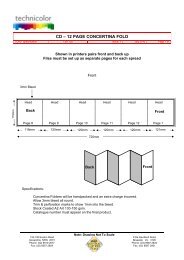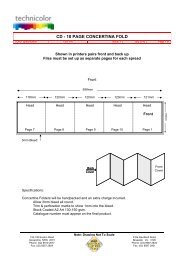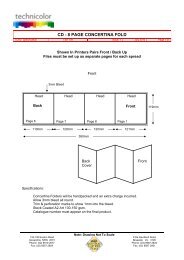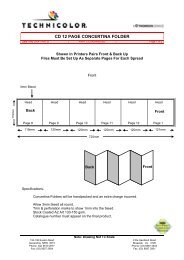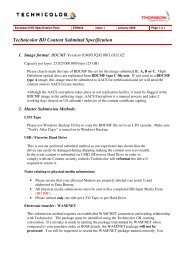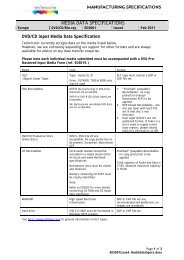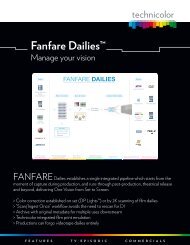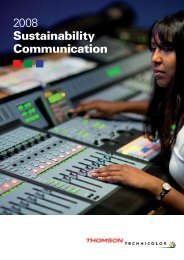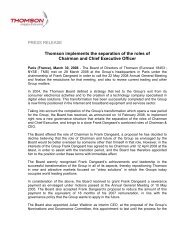FORM 20-F THOMSON multimedia - Technicolor
FORM 20-F THOMSON multimedia - Technicolor
FORM 20-F THOMSON multimedia - Technicolor
You also want an ePaper? Increase the reach of your titles
YUMPU automatically turns print PDFs into web optimized ePapers that Google loves.
we have limited operating history, the acceptance of our new products and services and expanded<br />
market presence by existing and new customers, the development of working relationships with new<br />
partners and the development of synergies among new and existing businesses. This strategy may<br />
encounter problems as we move into new business areas, and as new risks, some not yet known,<br />
related to dependence on new technologies or customers may develop and harm our future<br />
business prospects.<br />
Our acquisition strategy poses risks and uncertainties typical of such transactions.<br />
Our strategy and future growth depends in part on our ability to identify suitable acquisition<br />
targets, to finance and to achieve such acquisitions and to achieve and to obtain regulatory approval<br />
for these acquisitions. In addition, we will face risks associated with these acquisitions, including the<br />
integration of numerous entities and organizations, large numbers of persons and facilities and new<br />
relationships with different customers. We may also face an increase in our debt and interest<br />
expense. Potential difficulties inherent in mergers and acquisitions, such as delays in implementation<br />
or unexpected costs or liabilities, as well as the risk of not realizing operating benefits or synergies<br />
from completed transactions, may adversely affect our results.<br />
Technological innovations can make older products less competitive. We could be at a<br />
competitive disadvantage if we are unable to develop or have access, either independently or<br />
through alliances, to new products and technologies in advance of our competitors.<br />
The markets in which we operate are undergoing a rapid technological evolution resulting from<br />
the increasing use of digital technology and an increasing overlap among television, telecommunications<br />
and personal computers. Technological advances and new product introductions may render<br />
obsolete or significantly reduce the value of previously existing technologies, products and<br />
inventories. This could have a significant adverse effect on our ability to sell these products and to<br />
make a profit from these sales. For example, the emergence of digital technology has had this effect<br />
on many products using older analog technology. The emergence of new technologies could also<br />
have an adverse effect on the value of our existing patents.<br />
We expect that the development of digitalization and the convergence of television, telecommunications<br />
and personal computers will increase the pace and importance of technological<br />
advancement in our industry. As a result, we are investing large sums in the development and<br />
marketing of new products and services. These investments might be made in unproven<br />
technologies or for products with no proven markets and may therefore yield limited returns.<br />
Currency exchange rate fluctuations may lead to decreases in our financial results.<br />
To the extent that we incur costs in one currency and make our sales in another, our profit<br />
margins may be affected by changes in the exchange rates between the two currencies. Most of our<br />
sales are in U.S. dollars and in euro; however, a large portion of our expenses are denominated in<br />
Japanese yen, Mexican peso and Polish zloty, in particular those of our significant production<br />
facilities in Asia, Mexico and Poland. Ongoing plant relocation initiatives are likely to continue to<br />
increase the proportion of expenses incurred in emerging market currencies. While most emerging<br />
market currencies have been in decline in the recent past and have thus allowed us to reduce our<br />
manufacturing and procurement costs, an unhedged increase in the value of these currencies would<br />
increase these costs. Although our general policy is to hedge against these currency transaction<br />
risks on an annual or six month basis, given the volatility of currency exchange rates, we cannot<br />
assure you that we will be able to manage effectively these risks. Volatility in currency exchange<br />
rates may generate losses, which could have a material adverse effect on our financial condition or<br />
results of operations. For more detailed information on our hedging policies, see Item 11:<br />
‘‘Quantitative and Qualitative Disclosures about Market Risks’’.<br />
11



